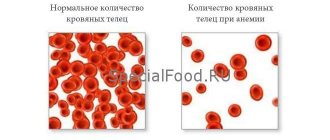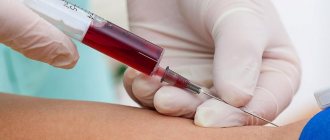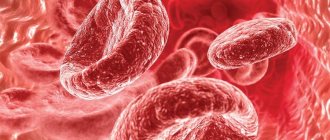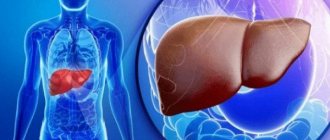What is the role of hemoglobin in the body
Hemoglobin is a physiological protein compound, a coloring substance present in red blood cells. Hemoprotein molecules contain iron atoms, which bind oxygen, are responsible for cholesterol and oxygen metabolism, and participate in the hematopoietic process. A healthy body contains about 4 g of iron. In the spleen, brain and liver - 1.5 g, in hemoglobin - 2.5 g.
Based on the results of a blood test for hemoglobin, the attending physician can
- establish the cause of weakness, fatigue, decreased metabolic rate;
- assess the quality of oxygen supply to cells;
- determine the level of acid-base balance - pH;
- recognize signs of developing anemia.
A person’s well-being is negatively affected by both increased and decreased levels of iron-containing hemoprotein. With a deficiency of hemoglobin in the blood, metabolic processes slow down, health worsens, and a whole bunch of ailments develops. A hemoglobin test that exceeds the norm may indicate the development of cardiovascular diseases or the presence of serious pathologies in the body.
As long as all indicators are within normal limits, a person feels cheerful and full of energy. The hemoprotein resource is sufficient to deliver oxygen to each cell and remove carbon dioxide through the lungs, preventing acidification of the body.
The importance of determining hemoglobin levels
Hemoglobin is an iron-containing protein found in red blood cells. It performs an extremely important function, ensuring the delivery of oxygen entering the blood to the tissues and cells of the internal organs.
When hemoglobin levels drop rapidly, cells do not receive enough oxygen, which negatively affects the functioning of the entire body.
The protein compound captures oxygen in the lung tissues and transports it to the body’s cells, ensuring their full functioning. Hemoglobin also captures and removes carbon dioxide from the body, which is a waste product.
Carbon dioxide accumulates in tissues, which leads to a deterioration in overall health and the development of such unpleasant symptoms as severe headaches, weakness, loss of strength, and pale skin. It is very important to promptly detect a decrease in hemoglobin and begin treatment. In its absence, complications such as a weakened immune system, tissue hypoxia, chronic insomnia, and heart failure may develop.
When is it necessary to take a hemoglobin test?
In modern medical practice, a blood test for hemoglobin is considered basic. The study is prescribed when registering pregnant women, to clarify the diagnosis if anemia or the development of other pathologies is suspected. Living in a deteriorating environment and constant mental and physical stress require careful attention to your health. Chronic fatigue, frequent depression, loss of interest in life are serious reasons to visit a doctor and get a referral for a blood test.
Indications for prescribing a hemoglobin test are:
- frequent headaches;
- the appearance of dry mouth;
- lethargy, drowsiness or painful insomnia;
- paleness of the skin, long-lasting bruises;
- severe thirst and increased urge to urinate;
- deterioration of vision and memory;
- poor healing of cuts and wounds;
- instability of psycho-emotional state.
Clarifying the level of hemoprotein in the blood is especially important for pregnant women carrying a child, parents planning to replenish the family, and patients with persistent hyperglycemia.
A blood test for hemoglobin itself does not eliminate the problem, but it can prompt dramatic lifestyle changes. Giving up bad habits, a balanced diet and proper rest can protect against irreversible changes in the endocrine system. To improve your quality of life and calmly greet each new day, it is enough to periodically set aside a few minutes to submit biomaterial for research.
Transcription of analyzes online.
cost of service: 500,300 rubles
Order
General practitioner Khanova Irina Ivanovna will interpret your tests during an online call in the Zoom or WhatsApp application.
- detailed explanation from the general practitioner.
- an alternative opinion from a competent specialist in interpreting the analyses.
- the opportunity to ask questions to the doctor regarding test results.
Consequences of low hemoglobin
Decreased immunity is a dangerous condition that cannot be ignored. It is accompanied by a serious deterioration in general well-being - a person is bothered by regular headaches, weakness, lethargy and loss of strength. In severe forms of iron deficiency anemia, severe dizziness and fainting may occur, attention disturbances, increased fatigue and muscle relaxation are often observed, which at an advanced stage can lead to urinary incontinence.
A decrease in hemoglobin below critical levels negatively affects not only a person’s well-being, but also his appearance.
As a result of lack of oxygen, skin, hair and nails dry out and become thinner, becoming dull and faded.
If iron-containing protein falls below normal, this negatively affects the immune system. As a result, a person is bothered by regular colds, as well as exacerbations of chronic diseases.
How to take a blood test for hemoglobin
To donate blood, no special preparation is needed, but there are rules that should be followed. Obtaining the most reliable result depends on them:
- hemoglobin test is taken in the morning on an empty stomach;
- the last meal is taken 10-12 hours before blood sampling;
- on the eve of going to the laboratory, it is recommended to avoid heavy physical labor, strenuous training, and stressful situations;
- Fatty foods and alcohol, which distort the data, must be eliminated from the diet within 24 hours.
To carry out the procedure, venous or capillary blood (from a finger) is taken. For prevention purposes, it is enough to undergo a test for hemoprotein levels once every 2-3 years.
Determining the amount of protein using a hemoglobinometer
Devices that measure the amount of hemoglobin in the blood are called portable. They have an automatic calibration function. A blood sample is collected using a classic laboratory method: about 20 μl of venous or capillary blood is drawn using a syringe with a needle. To prepare a photometric sample, the hemoglobin cyanide method is used.
The modern technique is recommended by WHO and has been used in medicine for forty years. The substance must be diluted in a ratio of 1 to 251 (this is done by a laboratory assistant). To prepare the sample, you will need five milliliters of reagent. The duration of sample preparation varies from 15 to 20 minutes and directly depends on the selected reagent used for analysis. The required sample volume for photometry is 2-4 ml.
To determine the amount of hemoglobin in the blood, you need to place a cuvette with a sample in the hemoglobinometer cell. After a few seconds, the iron protein concentration will appear on the display. The device automatically determines the amount of hemoglobin. It is not forbidden to shake it, heat it, and even turn it on before measuring the indicator (it turns on and off automatically).
After lowering the cuvette into the cell, the device automatically starts, measures the hemoglobin concentration and displays the result on the monitor. When the cuvette is removed from the hemoglobinometer, the device turns off. Repeated measurement is possible within 2-3 seconds after turning off the device.
Norms and deviations of hemoglobin as a result of analysis
The normal level of hemoglobin in the blood is a guarantee of good health for adults and children. The indicator for each person up to a certain age is approximately at the same level. In 2-week-old babies it is 135-200 g/l, at 1 year old it is 100-140, and at 12 years old it is already 114-145 g/l. The concentration of hemoprotein in the blood of strong healthy children is always higher.
The norm is different for men and women. The strong half of humanity is characterized by a hemoglobin test value of 130-160 g/l, for girls and women over 18 years old - 120-155. During menstruation it can drop to a level of 100 g/l. After 45 years, the hemoprotein content in both sexes may change upward.
An increased level of hemoglobin, recorded as a result of the analysis, in some cases indicates the presence of cancer problems, heart and intestinal pathologies.
A low rate is often associated with malnutrition, low-carbohydrate diets, hidden blood loss and blood diseases. It is observed in people suffering from diabetes, pancreatic tumors, and occurs in pregnant women.
Important! Whatever the results of a blood test for hemoglobin, it is strictly not recommended to make a diagnosis on your own and self-medicate. An experienced specialist from the Health of the Nation medical center will conduct a thorough examination, determine the exact cause of the ailment, and prescribe competent treatment.
Health is the main wealth that nature has awarded to humans. It should be taken care of by professionals.
Main symptoms of iron deficiency anemia
You can determine a low hemoglobin level yourself, without special equipment. To do this, you need to pay attention to the characteristic signs that may indicate the development of iron deficiency anemia. The main manifestations of low hemoglobin:
- headaches accompanied by dizziness or fainting;
- noise in ears;
- pale or yellowing of the skin of the face and body;
- lethargy, weakness, loss of strength;
- loss of appetite;
- muscle pain;
- decreased immunity and frequent colds;
- cold extremities;
- change in taste preferences - the desire to eat chalk, raw dough, eggshells.
Iron deficiency anemia is accompanied by a decrease in blood pressure, constant shortness of breath, rapid heartbeat, and heart rhythm disturbances. Also, a decrease in iron-containing protein in the blood leads to indigestion, changes in the color and consistency of stool. A lack of hemoglobin can also be detected by a person’s appearance. His skin becomes dry, acquires a jaundiced or pale tint, the conjunctiva of the eyes turns red, hair and nails become brittle, and their growth slows down.
Coulometric glucometers
This is a type of electrochemical meters. The principle of determining glucose concentration is similar to amperometric. Only in this case, it is not the current strength that is assessed, but the electric charge. The required volume of blood for analysis is minimal compared to all other devices.
Amperometric instruments are more often used in laboratory practice, while coulometric instruments are usually used for home use.
The two subtypes differ in the price of consumables. Patients with type 1 diabetes need to measure their glucose more often. Therefore, it is more profitable for them to acquire an amperometric device with cheaper test strips. Coulometric tests are recommended for the control of type 2 diabetes.
Rules for using a glucometer
Anyone can use this device at home. The main thing is to have consumables (test strips) in stock if the measurement is carried out using an invasive method. It is important to monitor their expiration date: damaged products will not provide the required accuracy.
Using a glucometer comes down to a few simple steps:
- thorough hand washing;
- disinfection of the puncture site;
- pricking the fingertip with a lancet;
- applying blood to the test strip;
- inserting the strip into the device.
The sequence of the last two steps depends on the type of device. The photometric strip is inserted with blood already applied. It is placed clean in the electrochemical one.
There is no need to insert express strips anywhere. Just wait for the color to change. With non-invasive it is even easier. It is only necessary to ensure contact with the skin (the area depends on the type of device).
Photometric glucometers
These devices read the change in color of a test strip onto which the patient's blood is applied. Such strips are coated with a reagent containing glucose oxidase. It gives specific responses to a particular level of glucose concentration, coloring the strip in the appropriate color.
You don't have to compare colors yourself. The scale is already stored in the device's memory. When a test strip is inserted into it, it compares its color with the values on this scale and produces a numerical result.
Such devices are easy to use, but quickly break down. In addition, their optical system is so fragile that there is a high probability of breaking the glucometer during operation. And if the lens becomes cloudy, the results may be distorted.
Electrochemical glucometers
Their action is based on the amperometric method of analysis. The test strips here are also lubricated with a reagent, but when they come into contact with blood, coloring does not occur. During the reaction, electric current is released. Its strength depends on the sugar level.
Electrochemical devices eliminate a number of disadvantages of photometric devices:
- increased strength;
- the accuracy of measurements has been increased (current strength is a specific value, as opposed to color);
- the required amount of blood for analysis has been reduced.
A child, an elderly person or simply a person with a low pain threshold will definitely prefer this type of sugar meter. The depth of the puncture depends on the required volume of blood. If less is required, the procedure is less painful.










